Everything you need to know about common hotel storytelling problems—and what you can do to avoid them.
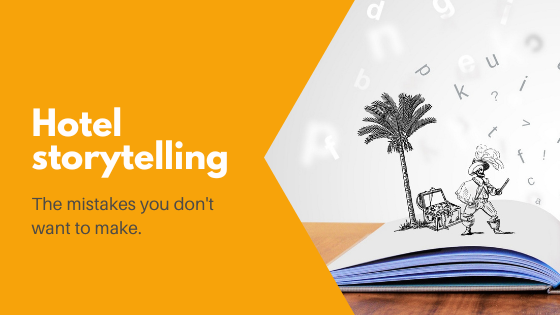
Brand storytelling? It ain’t easy!
[In the first part of this series, we tackled why we need storytelling in the hotel industry. In this follow up post, we take a look at the most frequent storytelling mistakes hotel brands make—and what you can do to avoid them.]
Hands down, hotel websites are some of the most stunning you’ll find on the web. Stylistically though, you’ll notice that hotel website designs seem to be moving in the same direction. They all look the same regardless of brand! (Case in point: Hotels in the Maldives.)
The problem is, similar designs make it that much harder to differentiate your hotel brand from the competition.
That’s where storytelling can save the day.

Are you making these common hotel storytelling mistakes?
Design aside, what sets you apart online is your brand story—your web copy, photos and videos, blog posts, and other carefully curated content shared on your digital channels. Unfortunately, many don’t get hotel brand storytelling right. Below are some of the most common hotel storytelling mistakes you don’t want to make!
⚠️ Is your website dated?
I know, I know. I just said that hotel websites are some of the most gorgeous ones you’ll find on the web. While that’s very true it’s also not always the case. In fact, there are still a lot of hotels relying on outdated websites.
But what does web design have to do with storytelling? It’s quite simple: Story building isn’t just about the words on the page. It’s the whole “package”—your choice of words, colors, and hero images. Offline, it encompasses the service offered and even the way your staff communicate with guests.
So, what are you saying with an outdated website? What impression would potential guests have if you haven’t upgraded your site since the early 2000’s? Can you effectively communicate the experience you’re promising with an old-fashioned website?
That’s why your website plays an essential role in the story you’re telling—and why there’s really no excuse for not modernizing it.
This common hotel storytelling problem is 100% avoidable.
If it’s the available budget that worries you, consider using free design templates to lower costs. If it’s getting it all set up that’s a problem, there are numerous how-to guides on the web at your disposal. And if it’s the text that has you stumped, hire a hotel copywriter.
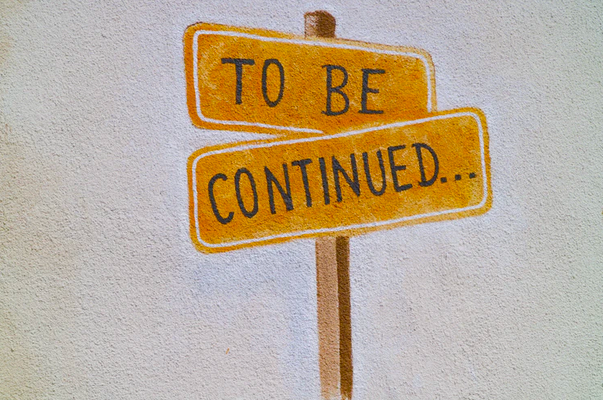
⚠️ Is your story incomplete?
As a hotelier, you know that no two hospitality brands are alike. But do potential guests agree? You see, one of the most common hotel storytelling problems is that of the story that’s only partially told. Or worse, still unwritten! For example: You’ve gone all out with your home page but left all other pages basic.
So what makes you different? What’s your strength? What can you claim about your brand or property or dining or service that others can’t?
Whether it’s an extraordinary location, a remarkable history to the property, inimitable design elements, a one-of-a-kind service philosophy, or how the brand embodies an impressive commitment to the environment or local community—those are all stories worth telling.
⚠️ Are you focusing on facts and figures only?
A potential guest’s mind is filled with many thoughts. Among them:
- “Is this the right accommodation for me?”
- “Will I like the property and its location?”
- “Does this brand share my values?”
- “What experience can I expect at this hotel and does it align with my personality?”
- “What will people think of me when I post about this stay on social media?”
If you focus only on facts and figures, potential guests will never have answers to those questions.
They’ll know that you have 35 attractive rooms and that you’re in a “top location”, but they won’t know where you stand relative to what matters to them.
Alternatively, if they somehow do get answers, they simply won’t be moved (read: inspired) by them.
They won’t be able to connect the dots between their current state and where they aspire to be, i.e. where they are right now relative to the dream of a certain type of vacation. And that’s a loss for your brand, because someone else, perhaps the property down the street, will make their position crystal clear and win that booking.

⚠️ Do you write for search engines first, humans second?
Writing to satisfy the mysterious search algorithm is another really common problem. And it’s really hard to miss because this type of writing is NOT a pleasant read. It focuses on keywords, so it often lacks feeling, personality, charm, and even flow. Reading this type of copy doesn’t spark joy, excitement, anticipation, and inspiration in the reader.
Remember this: Search engines aren’t your customers. People are. That’s why you need to be writing for them first and worrying about optimizing for search engines second.
⚠️ Do you get carried away?
Some hotel websites have too little text, others have far too much. And by far too much, I mean pages upon pages of material, most of which no one is ever going to read.
While it’s great that you’ve got a lot to share, keep your web copy focused, clean, and clear. Don’t distract from what truly matters and the core information people need to commit to booking with you.
If you’ve got a lot to say, think about setting up a hotel blog.
⚠️ Is your work a slapdash effort?
Here’s another common hotel storytelling problem: Web copy that’s either written in passing; in between tasks; or in a rush. In other words, not much thought, effort, or consideration went into its development. Text was needed, so text was written. But that’s it.
Remember that your web copy has to sell your product: Guest rooms, conference rooms, events, meals and drinks at your F&B establishments. If you aren’t grabbing attention, inspiring, setting expectations, and driving action, then you’re doing it all wrong.
To get it right, you need to understand who you’re targeting and how to appeal to them. You need to know what others are doing and where your brand fits in, in that landscape. You also need to know what your brand is all about.
Careless copywriting rarely gets the job done. So, when you sit down to write, focus on writing and writing only.
Storytelling stars and what you can learn from them
So now that you know what you shouldn’t do, are there any storytelling rock stars worth emulating?
Absolutely!
Plus, as you’ll see from these examples…
✅ You don’t have to be large hotel chain to have great stories.
In fact, boutique hotels, independent properties, and family-run accommodations often have the greatest stories to tell! “Small” does not mean uninteresting.
✅ A large budget isn’t a prerequisite for getting things right.
You just need ideas, time, and the drive to turn them into something interesting for your target market.
✅ You aren’t limited to your website.
Apply storytelling techniques to whatever channels and means are available to you! Whether it’s on social, through videos, or with regular blog posts, there’s always an opportunity to share a story.
So, let’s take a look at some important copywriting tips with awesome examples!
Tip #1 Commit to storytelling
If you’re going to tell a story, go all the way—incorporate it everywhere, on all pages, regardless of the type of information.
Remember that facts wrapped in a compelling story are remembered up to 22 times more than facts alone. Also, it’s really not storytelling if you’ve only bothered with it on your home page.
Visit the Shinta Mani Wild website and you’ll see what I mean. Their web copy doesn’t just set expectations – it’s also beautiful, down-to-earth, atmospheric and really engaging.
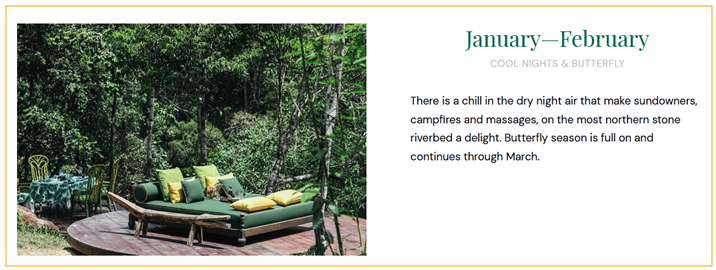
They could have given basic information on the best times to visit but instead, they’ve painted a picture of what each tropical season brings and the highlights that await the guest.
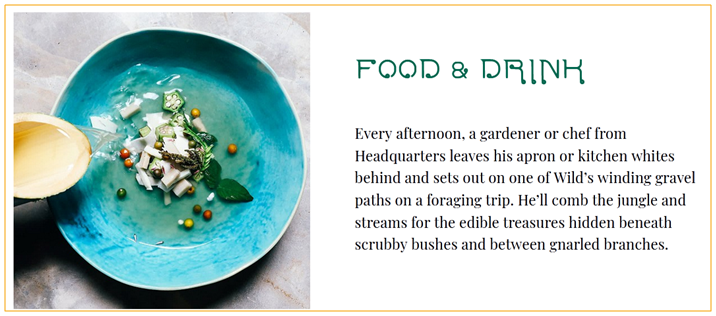
We’re not simply told that there’s local cuisine to be enjoyed. There’s a story about how ingredients are sourced, what kind of unique treats we will get to experience, and who are involved in making these meals come to life.

They don’t just describe what makes each specific tent (their version of guest rooms) special but also introduce readers to their Adventure Butlers, who are “part guide, part friend, part magician”.
Everything sets the mood, sparks wonder, and builds excitement. That can only be achieved through exceptional storytelling!
Tip #2: Go beyond words
When it comes to effective storytelling, it’s equally important to show and not just tell. That’s where quality photography and videos come in.
By incorporating visual media, prospective guests are better able to envision themselves at the property. They can go beyond imagining and actually see what the place looks like; take a peek into behind-the-scenes happenings; and even hear – in the staff’s own words – what kind of service and quality to expect.
Tip #3: Shine the light on what makes you unique

Among others, telling a great story involves:
- Knowing who you are and what makes you special;
- Understanding who your ideal customers are as well as what drives them;
- Then tying the two together in an authentic, cohesive, and clear manner to appeal to prospective guests.
When you manage to do that, you’re able to craft a memorable story that resonates with the type of customers you want to have at your property. What you’ve written has your brand’s unique voice; it exudes your distinct personality and charm, so it’s never a boring, repetitive or generic read. It’s actually interesting!
You put the spotlight on what differentiates you from all the other accommodation options on the market.
Tip #4: Stories are everywhere
“No one will find that interesting.”
“That’s too boring to share.”
“I’m out of ideas.”
Those are some of the most common (plus relatable) excuses you’ll hear for why your team hasn’t been able to develop new content for your blog.
They’re excuses because stories can be found everywhere: Day-to-day activities, behind-the-scenes happenings, specific features at your property—they’re all sources of content.
You might see it as a stunning view from your rooftop infinity pool, but a prospective guest sees magical sunset moments enjoyed with their loved one.
Whether it’s your organic vegetable garden, the chef’s daily trips to the local market, local fruits that are in season, details on select pieces of art at the property, or the great lengths housekeeping go to, to ensure safe and clean surroundings, there’s a story worth telling in everything, no matter how mundane.
There’s nowhere better to see that in action than on Mashpi Lodge’s blog.
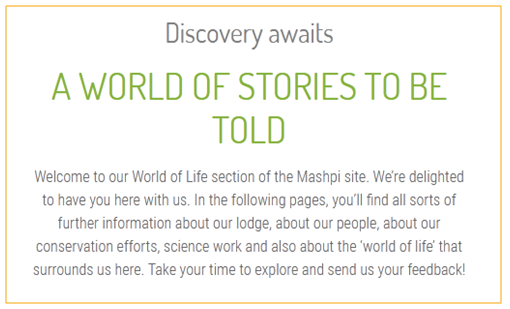
Their blog invites you to explore their world – their property, the team that makes everything happen, the surroundings, and more. Beyond being a fascinating sneak peak of what to expect, it gets you invested in the property—and excited to experience everything for yourself!
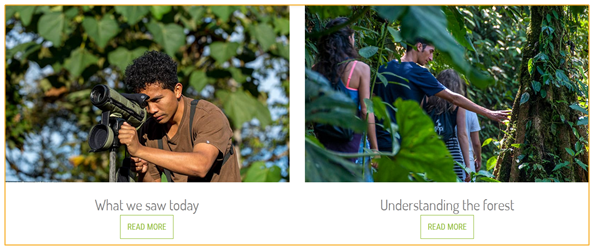
You don’t need every piece of writing to provide thrills. Posts can be introspective, insightful, educational, fun, or simply useful – like Mashpi Lodge’s Cloud Forest Fruit Cake recipe!
Content is king and the awesome posts you share on your blog will be your best asset when it comes to the art of soft selling.
Another notable mention is Marriott’s collection of travel tips and more.
To conclude, you’ve nothing to lose and everything to gain by incorporating storytelling in your hotel’s digital marketing strategy.
So, how many of these hotel storytelling problems have you made? And more importantly, what are you going to do to fix them?